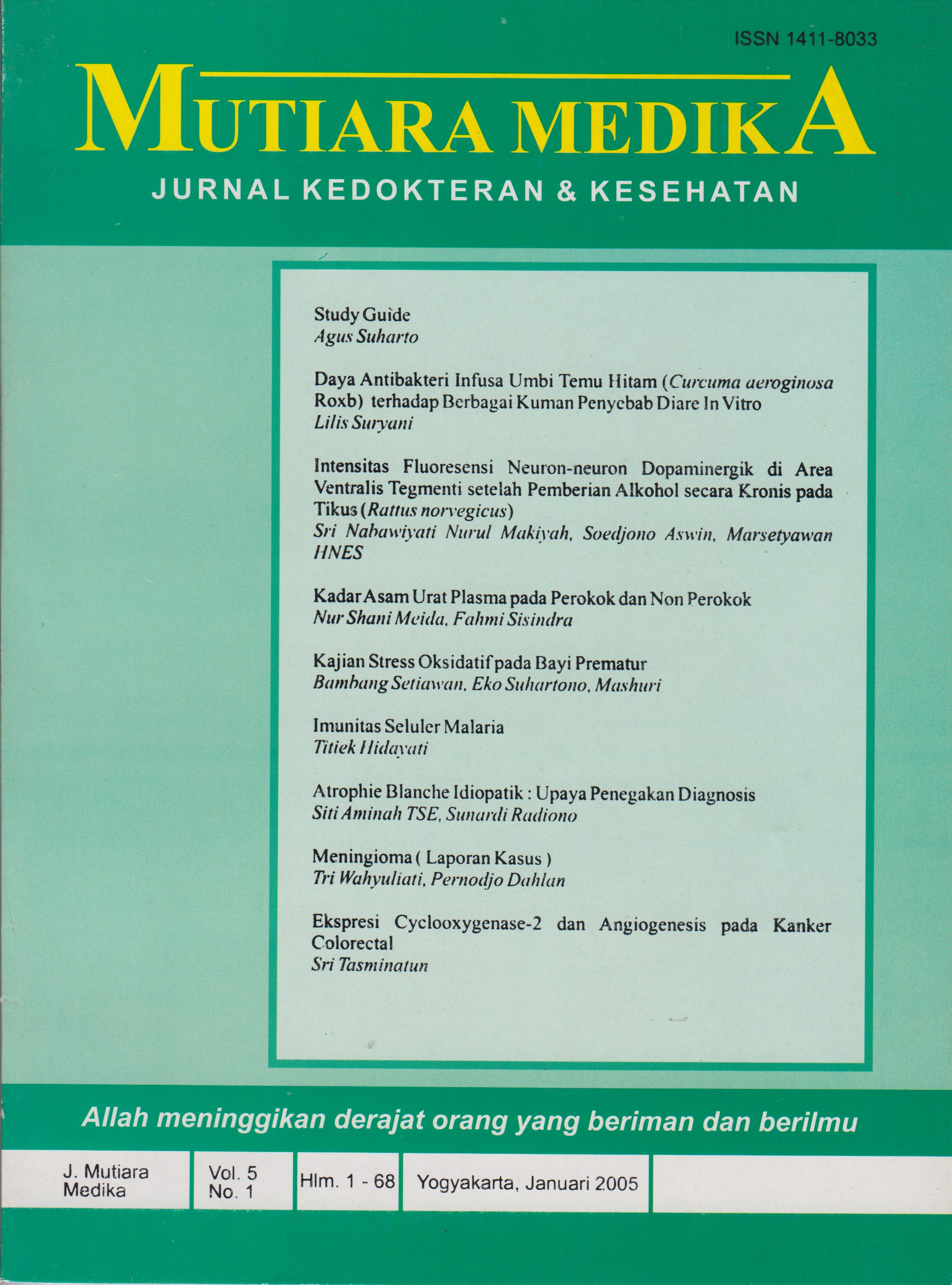Daya Antibakteri Infusa Umbi Temu Hitam (Curcuma aeroginosa Roxb) terhadap Berbagai Kuman Penyebab Diare In Vitro
DOI:
https://doi.org/10.18196/mmjkk.v5i1.1862Keywords:
Umbi temu hitam {Curcuma aeroginosa Roxb), daya antibakteri, KHM, Temu Hitam tuber {Curcuma aeroginosa Roxb), antibacterial activity, MIC, MBC, KBMAbstract
Diarrhoea remain a serious health problem in Indonesia. People often use the medicine plant to cure diarrhoea. The medicine plant tike Temu Hitam tuber (Curcuma aeroginosa Roxb) has been used commonly against skin dis¬eases, respiratory diseases as well as digestive diseases (diarrhoea). Microor¬ganism causing diarrhoea include Escherichia coli, Shigella dysenteriae and Vibrio cholerae.This research is an experimental laboratory study to observe the anti-bacterial activity of Temu hitam (Curcuma aeroginosa Roxb) tuber infusion against Escherichia coli, Shigella dysenteriae, and Vibrio cholerae.
The antibacterial activity of Temu hitam (Curcuma aeroginosa Roxb) tu-ber infusion has been tested by the determination of the minimal inhibitory con-centration (MIC) and minimal bactericidal concentration (MBC) using tube di-lution method.
The result of this study shows that the MIC and the MBC of Temu hitam (Curcuma aeroginosa Roxb) tuber infusion against Escherichia coli is 22,2gr% and >25gr%, Shigella dysenteriae ll,lgr% and >25gr%, Vibrio cholerae l,91gr% and >25gr% respectively.
As a conclusion, it is obvious that Temu hitam {Curcuma aeroginosa Roxb) tuber infusion possess an antibacterial activity against Vibrio cholerae, Shigella dysenteriae and Escherichia coli as bacteriostatic. Temu hitam {Curcuma aeroginosa Roxb) tuber infusion has the highest antibacterial activity against Vibrio cholerae while the lowest antibacterial activity is shown against Escherichia coli.
Di Indonesia penyakit diare (mencret) masih merupakan masalah serius di bidang kesehatan terutama di daerah pedesaan. Masyarakat di pedesaan sering menggunakan tanaman obat untuk mengobati diare. Salah satu bahan tanaman yang berkhasiat obat adalah umbi temu hitam {Curcuma aeroginosa Roxb). Tanaman ini banyak dipakai sebagai obat tradisional mempunyai khasiat untuk meningkatkan nafsu makan, mengobati penyakit kulit, ruam, borok, obat mulas-mulas, peluruh angin, penambah darah, batuk dan sariawan.
Penelitian ini merupakan penelitian eksperimental laboratorik yang bertujuan untuk mengetahui daya antibakteri infusa umbi temu hitam {Curcuma aeroginosa Roxb) terhadap beberapa bakteri penyebab diare yaitu: Escherichia coli, Shigella dysenteriae dan Vibrio cholerae.
Daya antibakteri ditunjukkan dengan melihat kadar hambat minimal (KHM) dan kadar bunuh minimal (KBM) infusa umbi temu hitam {Curcuma aeroginosa Roxb) terhadap kuman tersebut dengan metode pengenceran tabung {tube dilution method).
Hasil penelitian ini menunjukkan bahwa KHM infusa umbi temu hitam {Cur-cuma aeroginosa Roxb) berturut-turut terhadap kuman Escherichia coli 22,2gr%, Shigella dysenteriae 11,1 gr% dan Vibrio cholerae l,91gr%. KBM infusa umbi temu hitam {Curcuma aeroginosa Roxb) berturut-turut terhadap kuman Escherichia coli >25gr%, Shigella dysenteriae >25gr% dan Vibrio cholerae >25gr%.
Dari hasil penelitian tersebut disimpulkan bahwa infusa umbi temu hitam {Cur-cuma aeroginosa Roxb) mempunyai daya antibakteri terhadap kuman Escherichia coli, Shigella dysenteriae dan Vibrio cholerae. Infusa umbi temu hitam {Curcuma aeroginosa Roxb) mempunyai daya antibakteri yang kuat terhadap kuman Vibrio cholerae dan lemah terhadap kuman Escherichia coli. Daya antibakteri infusa umbi temu hitam terhadap Escherichia coli, Vibrio cholerae, dan Shigella dysenteriae bersifat bakteriostatik.
References
Fauziah,M., (1999), Temu-temuan dan empon-empon, Edisi I, Penerbit Kanisius, Yogyakarta.
Departemen Kesehatan RI, (1985), Cara Pembuatan Simplisia, Direktorat Jenderal penelitian Obat dan Makanan, Jakarta.
Fransworth,NR., (1986), Biological Screening of Plants, Journal Pharmacology Science Phytocemical 55(3): 265-268.
Anonim, (1979), pemanfaatan tanaman Obat, Edisi III, Departemen Kesehatan Republik Indonesia, Jakarta: 122-123.
Tallarida,RJ., Murray,RB., (1981), manual of Pharmacology Calculatio, Springer Verlay, New York, Heidelberg, Berlin: 19-22.
Tyler,et al., (1977), Minyak Atsiri, Edisi I, Indonesia Press, Jakarta: 19-20.
Wagner,H., Bladts, Zgainski,EM., (1984), plant Drug Analysis, A Thin Layer Chromatography Atlas, Spronger Vertag, Berlin, Haidelberg, Tokyo: 163-165.
Joklik,WK., Willet,HP., Garelick,H., (1992), Zinsser Microbiology, 20 edition, Norwalk, Appleton & Lange, San mateo, California: 544- 547.
Taussig,MJ., (1986), Processes in Pathology and miccrobiology, 2nd ed., Blackwell Scientific publications, Melbourne: 387-404.
Jawets,E., Brooks,GF., Melnick,JL., (1996), Medical Microbiology, 20 edition, Appleton and Lange Prentice Hall International Inc, USA: 235-238.
Downloads
Issue
Section
License
Copyright
Authors retain copyright and grant Mutiara Medika: Jurnal Kedokteran dan Kesehatan (MMJKK) the right of first publication with the work simultaneously licensed under an Attribution 4.0 International (CC BY 4.0) that allows others to remix, adapt and build upon the work with an acknowledgment of the work's authorship and of the initial publication in Mutiara Medika: Jurnal Kedokteran dan Kesehatan (MMJKK).
Authors are permitted to copy and redistribute the journal's published version of the work (e.g., post it to an institutional repository or publish it in a book), with an acknowledgment of its initial publication in Mutiara Medika: Jurnal Kedokteran dan Kesehatan (MMJKK).
License
Articles published in the Mutiara Medika: Jurnal Kedokteran dan Kesehatan (MMJKK) are licensed under an Attribution 4.0 International (CC BY 4.0) license. You are free to:
- Share — copy and redistribute the material in any medium or format.
- Adapt — remix, transform, and build upon the material for any purpose, even commercially.
This license is acceptable for Free Cultural Works. The licensor cannot revoke these freedoms as long as you follow the license terms. Under the following terms:
Attribution — You must give appropriate credit, provide a link to the license, and indicate if changes were made. You may do so in any reasonable manner, but not in any way that suggests the licensor endorses you or your use.
- No additional restrictions — You may not apply legal terms or technological measures that legally restrict others from doing anything the license permits.



